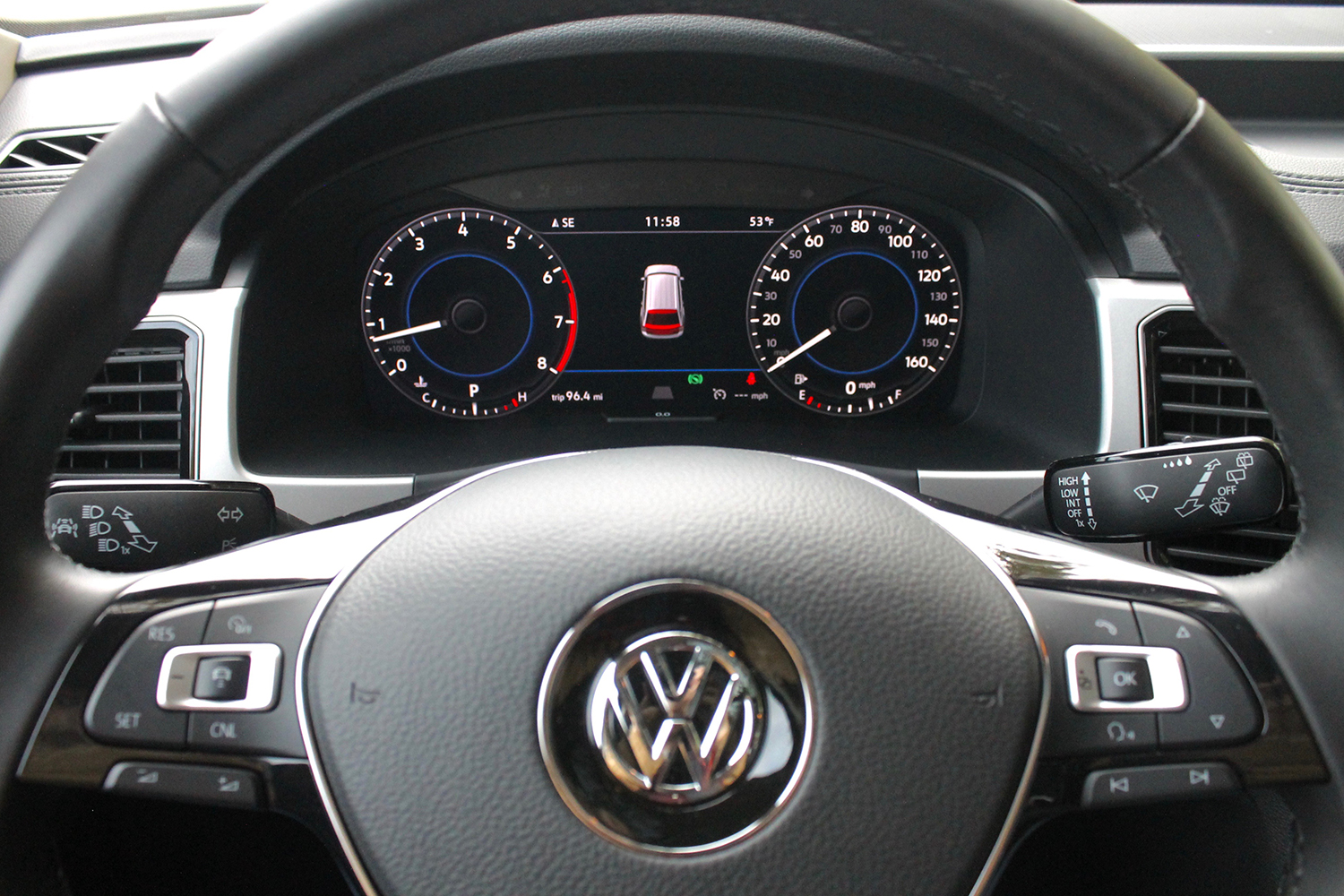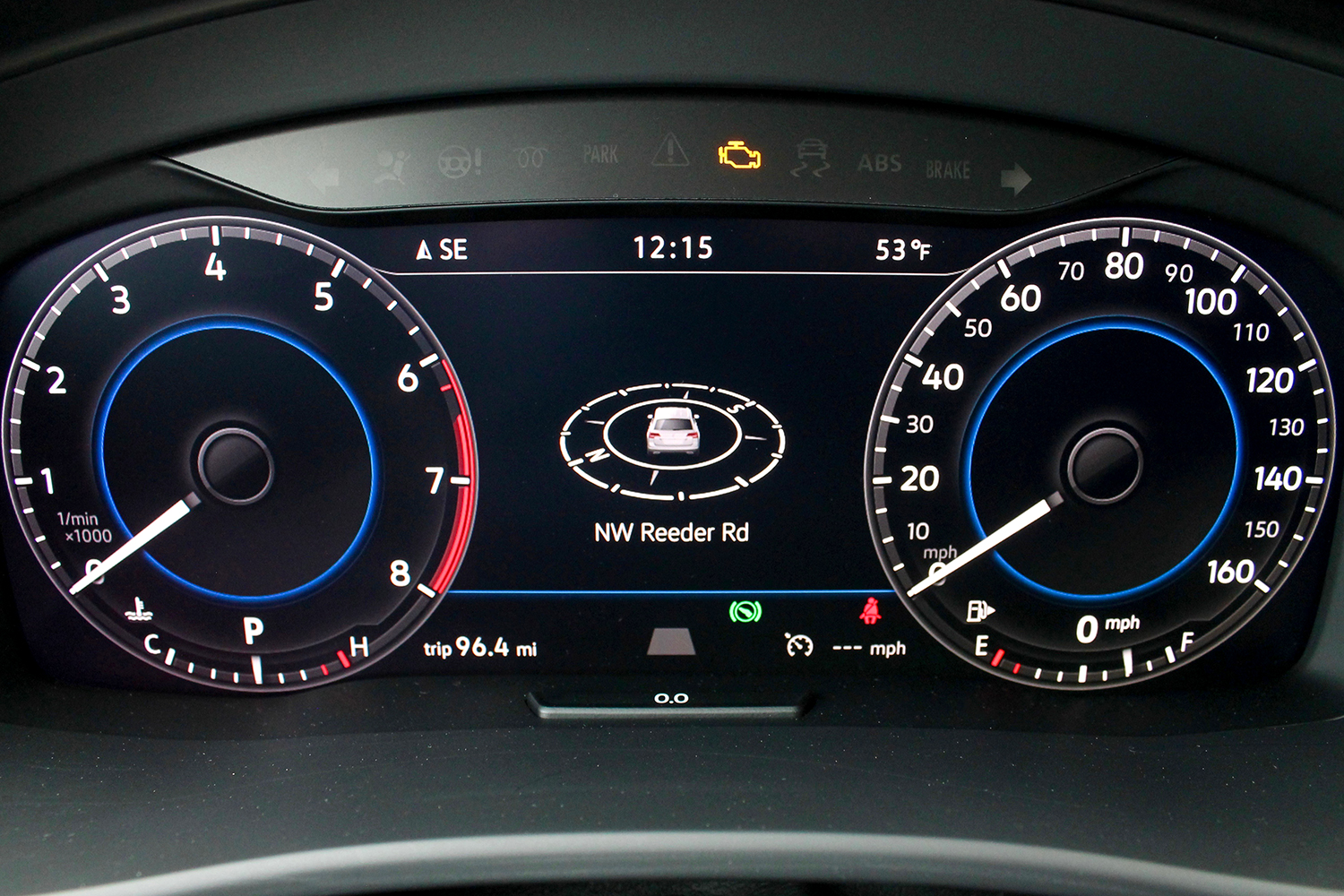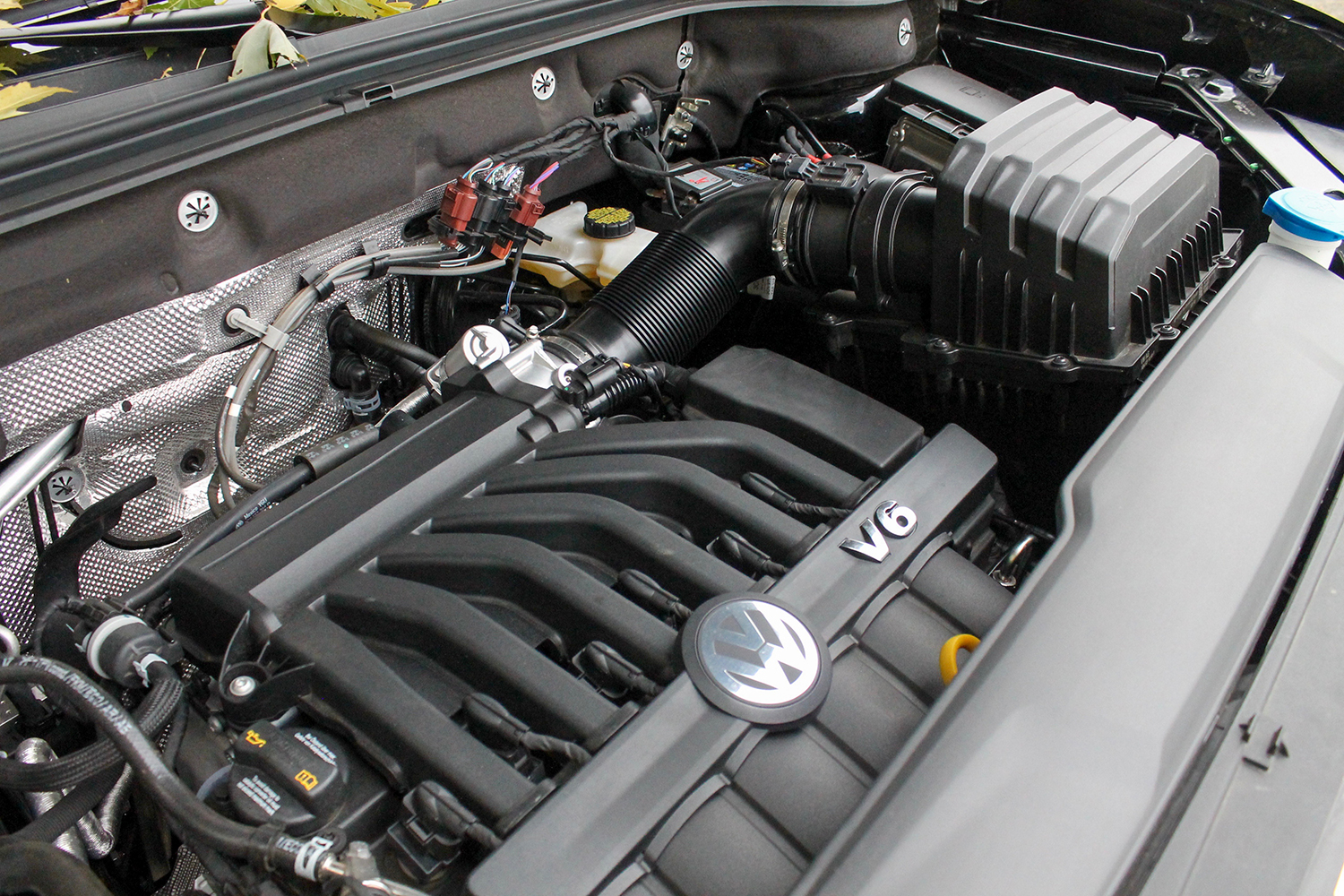“It took awhile for Volkswagen to build a proper midsize SUV, but the tech-packed Atlas was worth the wait.”
- Cavernous, comfortable interior
- Intuitive and clever tech
- Drives smaller than it looks
- A useable third row!
- V6 feels underpowered for the price
- Thirsty
For the last few years, the crossover SUV market has been hotter than a Carolina Reaper. More people buy crossovers today than any other type of vehicle, and the reason is simple – crossovers work like SUVs but drive like cars. For Volkswagen, though, reception has been mild at best. Honda sold about 360,000 CR-Vs last year, and that’s about the same number of Tiguans and Touaregs VW has moved in total since 2002. Those aren’t exactly high marks, so heading into our 2018 Volkswagen Atlas review, we were hoping for a nice change of pace.
The Atlas was built “specifically with the American customer in mind.”
While the Tiguan and Touareg are fine vehicles, most buyers find them to be too expensive for their class and too small for big families. That’s why when VW began building the Atlas, they set their sights squarely on crossover country – the good ol’ US of A. That’s right, the Atlas was built “specifically with the American customer in mind.”
The Atlas is the biggest, boldest, and most tech-packed VW on the market, and it’s the automaker’s first three-row midsize product. It has the room to haul families in comfort and the features to coddle them, but it does all of this in a simple, intuitive way. It’s blocky and angular like many American SUVs as well, and it’s even built in cattle country, Tennessee. So it may come from a German company, but the Atlas feels about as American as apple pie.
That’s a good thing, by the way.
What’s new
Almost everything. The Atlas is an all-new vehicle for the 2018 model year, but it’s not a complete stranger. That’s because the crossover is built atop the same scalable MQB platform that underpins everything from the VW Golf to Czechoslovakia’s Skoda Kodiaq, Much of the Atlas’ equipment – such as the basic infotainment system and engine choices – can be found in other VW products, but options like the Digital Cockpit instrument cluster are debuts for the brand.
Trim levels & features
The Atlas offers six trim levels – the S, S Launch Model, SE, SE w/ Tech, SEL, and SEL Premium – and they range in price from $30,500 all the way up to almost $50,000. The base model includes a 2.0-liter turbocharged four-cylinder that produces 235 horsepower and 258 pound-feet of torque, and it sends that power to the front wheels via an eight-speed automatic transmission. Standard features are quite nice for an entry-level choice, and they include a 6.5-inch touchscreen, LED headlights, Bluetooth, Apple CarPlay, and Android Auto.
That version wasn’t available at launch, however, so our tester – the range-topping V6 SEL Premium 4Motion – sat on the opposite end of the economic spectrum. For $49,415 (including destination charges), you get all-wheel drive, a 3.6-liter V6 with 267 hp and 266 lb-ft, leather seats in all three rows, an 8-inch touchscreen, gigantic panoramic sunroof, 12-speaker Fender audio system, a myriad of driver assist systems, and the Digital Cockpit.
No matter which trim you choose, though, you’ll the bold and brawny styling you’d expect from a car named the Atlas. Instead of the smooth, elegant aesthetic you find in many crossovers and minivans, the Atlas is a bonafide chunk, with sharp angles and squared-off proportions littering the grill, fenders, rear fascia, and even the cabin. It skillfully avoids the much-chagrined “standby soccer coach” look, and we think the styling will age well in years to come.
Technology overview
It’s easy to shove a bunch of high-tech features into a car, but making them work together in an intuitive way is much more difficult. VW has done that with the Atlas, because even though there are more tech highlights here than in any other VW, you don’t need to attend a college course or even open the owner’s manual to understand them.
Let’s start with the infotainment system. SEL Premium models wear an 8-inch center touchscreen complete with all the goodies – Android Auto, Apple CarPlay, Bluetooth, navigation, and satellite radio. The screen is quick and responsive to the touch, the animations are smooth and smartphone-like, and the in-house navigation system is a snap to use. Its “2.5D” map displays aren’t quite as pretty as the 3D renderings you’ll find in the Audi Q7, but given the price differential between the two brands, that’s to be expected.
There are more tech features in the Atlas than in any other VW, but you don’t need a college course to understand them.
Our favorite tech feature on the Atlas sits directly ahead of the driver, and it’s dubbed the Digital Cockpit. Replacing boring analog gauges with futuristic eye candy, the 12.3-inch Digital Cockpit is fully customizable, allowing drivers to place what’s most useful to them right in front of their eyes. Fuel economy numbers, driver assistance information, media settings, and off-road figures like driving angle and altitude can be highlighted in different ways. You can even plug the map in between the gauges so your eyes stay focused on what’s ahead of you.
Outside of all the fancy stuff, the Atlas has you covered with the basics like power outlets and USB ports. The base Atlas S has two USB ports and a 12-volt power outlet up front, and on SE trims and above, two more appear in the center console alongside a 115-volt power plug. Speaking of power, the optional 12-speaker Fender audio system is spectacular, with a big bass punch and crystal clear playback regardless of seating position.
Interior fit & finish
In many cars, the interior is a design exercise, full of cascading lines and trim pieces meant to flow together harmoniously like a watercolor painting. The Atlas’ cabin certainly isn’t ugly – it’s actually quite comfortable and upscale – but aesthetics take a literal backseat to cargo space, practicality, and easy-to-maneuver chairs. This is a family car after all, and screaming kids don’t really care about the matte finish on your walnut dashboard accents.
We could go on and on about the SEL Premium’s heated and ventilated front leather seats, but let’s start by jumping all the way to the rear. The third row is very, very impressive in the Atlas, and that’s because for once, you can actually fit human beings above the age of five back there. It’s likely the roomiest and most comfortable third row in the segment, able to fit six-foot-tall adults without obliterating their knees. The Atlas beats the Chevy Traverse, Honda Pilot, Dodge Durango, and Mazda CX-9 in third-row legroom, and we were recently in a GMC Yukon (which is six inches longer than the Atlas), and the third row felt considerably more cramped. It may not be the sexiest detail in the world, but for a big family, a useable third row can make the difference between buying a car and not.
The 60/40 second-row bench is quite nice as well. It’s very spacious as you may have guessed, and it slides back and forth with ease. It even does so with a child seat attached, which most of the Atlas’ competitors will not do. With the second and third rows folded, the Atlas boasts 96.8 cubic feet of cargo space, and that’s nothing to shrug about.
Driving performance & MPG
The Atlas is a big car, but it doesn’t feel like it behind the wheel. VW’s MQB platform and clever suspension tuning come together to give the family-hauler a spry, agile feel from the driver’s seat, and it handles itself confidently when cornering and braking. It’s not as dynamic as the more driver-focused Mazda CX-9, but it is comparable, and the ride quality is buttery even over rough roads. The brakes feel solid as well, although they do seem a bit grabby when you first put your foot down.
The optional V6 is underwhelming from both acceleration and fuel economy standpoints.
The engines, unfortunately, are the most prominent low points with the Atlas. We didn’t get a chance to evaluate the base 2.0-liter, but the optional V6 is underwhelming from both acceleration and fuel economy standpoints. 0 to 60 mph comes in 7.9 seconds with the six-cylinder, and that’s slower than the Honda Pilot V6, GMC Acadia V6, Chevy Traverse V6, Dodge Durango V6, and even the Mazda CX-9 turbo four-cylinder. The deficit will be most noticeable when passing slow vehicles on the freeway or driving up hills, but around town, performance is what we’d call … fine.
Official fuel economy ratings sit at 17 mpg city, 23 mpg highway, and 19 mpg combined with the V6, and once again, those figures sit near the bottom of the class. In the real world, we underperformed and returned about 18 mpg combined. In terms of performance statistics alone, the Mazda CX-9, Ford Explorer V6, and Honda Pilot V6 are the top dogs in the midsize SUV class.
Safety
Safety is an important concern for every vehicle, but with a family-friendly car like this, it’s paramount. The 2018 Atlas was named a Top Safety Pick by the Insurance Institute for Highway Safety, and it also received top marks in all crash tests. Additionally, the vehicle was awarded a five-star overall rating from the National Highway Traffic Safety Administration.
Features like autonomous emergency braking with pedestrian detection, adaptive cruise control, lane keeping assist, and an overhead view camera are available to give drivers extra peace of mind, however only the rear camera comes standard. To get most of the good stuff, you’ll need to shell out $35,690 for the SE w/ Tech model.
How DT would outfit this car
Surprise surprise, we totally geeked out over the Atlas’ sleek Digital Cockpit, but we’re actually not recommending it here. That’s because the only way to get it is by plunking down a hefty $48,490 for the flagship V6 SEL 4Motion trim. Instead, we recommend saving yourself almost $10,000 and opting for the V6 SE w/ Tech option.
With that model, you still get an impressive feature set – V6 power, all-wheel drive, an 8-inch touchscreen, eight-speaker stereo, heated front seats, leatherette upholstery, Android Auto/Apple CarPlay, extra USB ports, and Bluetooth. A myriad of driver aids come along for the ride as well, including adaptive cruise control, lane assist, automatic emergency braking, blind spot monitor with rear traffic alert, and a rearview camera. With most of the features we want taken care of, we’d select the Reflex Silver Metallic paint to hide scratches and a four-bike rack system by Thule to make family trips even more fun. VW offers the bike rack as a $400 accessory.
Our Take
The car you drive says a lot about you. Imagine the driver of a neon green Mercedes-AMG GT S, and how different that person is likely to be than someone driving a fuel-sipping Toyota Prius. How about a Bentley Bentayga driver versus someone with a Honda Civic Type R? Considering the Atlas was designed with Americans in mind, the three-row crossover in fact says a lot about us. We like big, comfortable cars with room for our kin, we like clever tech that doesn’t take a master’s degree to understand, and we like things that are priced competitively. The Atlas isn’t flawless, but it exemplifies American driving more than any other VW before it, and for that reason, it’s likely to turn the automaker’s SUV failings into a success story.
Is there a better alternative?
The midsize SUV segment is one of the most competitive in the industry, and thus the Atlas has many rivals. The Honda Pilot, for instance, is a very well-built car for a good price, but the Atlas’ tech is miles ahead and it’s more engaging to drive. Speaking of engagement, the Mazda CX-9 is decidedly more dynamic than the Atlas, but it falls flat when discussing the all-important cargo volume and third-row space metrics. The Kia Sorento is a stellar value option too, but its 73 cubic feet of cargo volume pales in comparison to the VW’s.
As it always does, your individual preferences will guide you in the right direction. Do you prioritize performance over practicality? Opt for the GMC Acadia V6, which does 0 to 60 in 6.3 seconds. Want something better on gas? Consider the front-wheel-drive Honda Pilot, which returns 27 mpg on the freeway. But if you fit in with the majority of crossover SUV shoppers, tech, storage, and utility are your main priorities, and it’s in those areas the Atlas shines over the competition. It simply covers more bases better than the others.
How long will it last?
The Atlas has not received reliability ratings from JD Power or KBB as of this writing, but VW products generally fall in the average to above average area. In terms of warranties, VW offers a six-year/72,000-mile bumper-to-bumper warranty. That’s better than the Audi Q7’s warranty and the same as the Honda Pilot’s.
Should you get one?
The Atlas has some blemishes, but it is without a crippling downside. Most SUV drivers don’t care about breakneck acceleration, and fuel economy is a slightly lower priority in vehicles that regularly haul youth soccer teams. There are options that perform better in those areas than the Atlas, but none of them are as practical or interesting from a technology standpoint. The Atlas has the space, it has the storage, and it has the stuff to keep seven passengers satisfied on long drives. If extended family trips are in your future, you should absolutely give the Atlas a solid look.
















